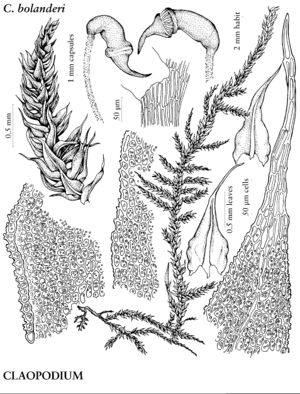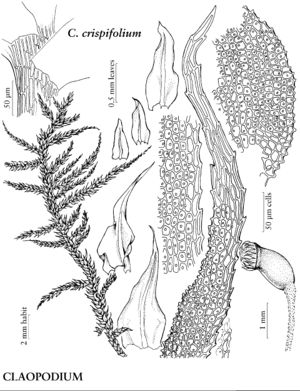Claopodium
Rev. Bryol. 20: 16. 1893.
| Taxon | Illustrator ⠉ | |
|---|---|---|
 | Claopodium pellucinerve Claopodium bolanderi | Patricia M. Eckel Patricia M. Eckel |
 | Claopodium whippleanum Claopodium crispifolium | Patricia M. Eckel Patricia M. Eckel |
Plants small to medium-sized, in creeping mats, green to yellowish. Stems irregularly to regularly pinnate; paraphyllia absent or few, scalelike or squamiform, cells smooth or papillose; rhizoids often arising from base of leaves. Stem and branch leaves similar. Stem-leaves crisped, incurved to slightly contorted when dry, erect and spreading when moist, ovate, ovatelanceolate, or lanceolate, not plicate; margins plane, serrate or entire, limbidium sometimes present; apex gradually or abruptly acuminate, hairpoint present or absent; costa single, ending before apex, pellucid, straight distally; alar cells not differentiated; medial and distal laminal cells quadrate-hexagonal, oblong, or rhomboidal, finely and obscurely 1- or multipapillose over lumen, walls moderately thick. Specialized asexual reproduction absent. Sexual condition dioicous; perichaetial leaves pale translucent, longer, apex more acuminate. Seta to 2 cm. Capsule inclined to horizontal, oblong-oval, asymmetric; annulus present; operculum conic to long-rostrate; peristome well developed; exostome teeth lanceolate, densely cross striate-papillose basally, papillose distally; endostome basal membrane high, segments slender, cilia long. Spores 9–21 µm, smooth or papillose.
Distribution
w North America, Mexico, w Europe, e Asia, Pacific Islands (Hawaii)
Discussion
Species 8 (4 in the flora).
Claopodium is a genus of small plants with creeping stems, short, papillose laminal cells, pellucid costa, and asymmetric brown capsules with a well-developed peristome. The leaves are broad at the base; the capsules have short necks, are constricted below the mouth when dry, and have bordered exostome teeth and nodose endostome cilia. The genus is somewhat heterogeneous, as C. whippleanum lacks hair-points and superficially is similar to Leskea. Recent phylogenetic work suggests that Claopodium is related to Anomodon (Anomodontaceae).
Selected References
None.
Lower Taxa
Key
| 1 | Stem surface cells papillose; laminal cells multipapillose; leaf hair-points present | Claopodium pellucinerve |
| 1 | Stem surface cells smooth; laminal cells 1- or multipapillose; leaf hair-points present or absent | > 2 |
| 2 | Leaf hair-points absent; laminal cells 1-papillose. | Claopodium whippleanum |
| 2 | Leaf hair-points present; laminal cells 1- or multipapillose | > 3 |
| 3 | Laminal cells 1-papillose. | Claopodium crispifolium |
| 3 | Laminal cells multipapillose. | Claopodium bolanderi |
"broad" is not a number.